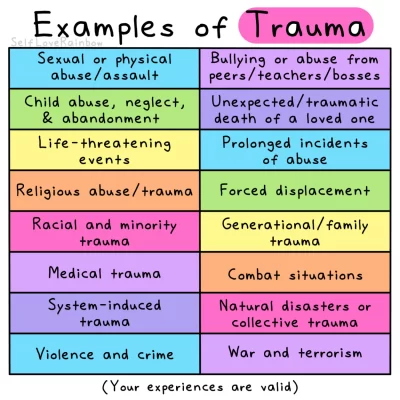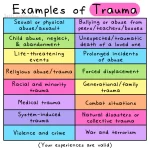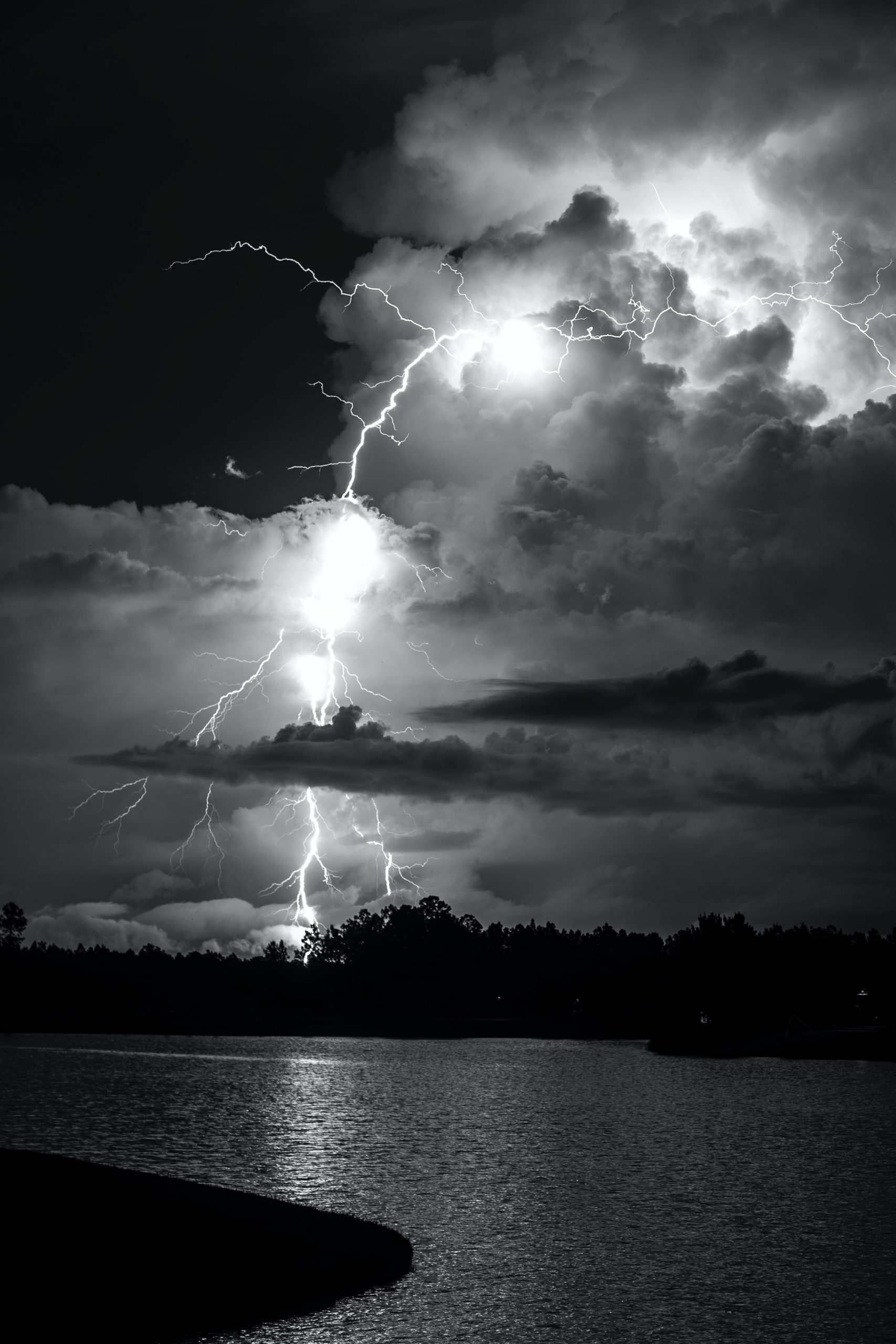Category: Trauma
First Responder Trauma and Recovery
The posts you will discover at Sawayer Logistics PLLC (sawayer.com), addressing First Responder and Trauma Recovery will provide resources for the various professions exposed to trauma at different levels.
Trauma is a concept that is fairly new, having evolved in the last 20 years and brought to the fore due to the diagnostic label of Post Traumatic Stress Syndrome (PTSD) of soldiers returning from theaters of war overseas.
As a result, the more general term of trauma has evolved for a more generic application.
According to the American Psychological Association, trauma is an emotional response to a terrible event. Trauma can occur once, or on multiple occasions and an individual can experience more than one type of trauma.

Post Traumatic Stress Syndrome (PTSD), is the mental health disorder that is associated when someone experiences or witnesses a trauma.
Here is the link to the ICD-10
Further, traumas’ impact the relationships of those very same first responders that it originally traumatized.
These first responder groups addressed here will include, but are not limited to: corrections personnel, law enforcement personnel, emergency dispatchers, active military, Veterans, physicians, nurses, EMT personnel, fire fighters, morticians, medical examiners, social workers, counselors, those serving congregations of different faiths, and Hospice staff to mention just a few.
We will explore some situations that create post traumatic stress syndrome, as well as outline the symptoms experienced and the criteria for meeting a formal diagnosis.
Additionally, we will also provide useful resources and links in the process.
We welcome feedback and suggestions for adding additional professional groups that are trauma exposed.
Talking about Near Death Experiences to Others
There are some experiences that are still mysterious and difficult to describe in language.
https://youtu.be/TjlFrgS_53Y
The experience of clinically dying and then being brought back to life sometimes bestows an individual with an experience of being transported to unexplainable places in other time dimensions. These experiences are labeled as Near-Death Experiences or NDEs.
The Out of Body Experience, labeled OBOs, occur following physical trauma and unconsciousness, have allowed some individuals to see themselves from out of and above their bodies, while simultaneously witnessing, in apparent real time, those very lige saving efforts that eventually bring them back to life.
Such people have gained credibility because they are able to report seeing people and experiencing events that occurred as they were being resuscitated.
Unlike those individuals experiencing NDEs, language remains intact for explaining these experiences.
Science has been documenting and quantifying both of these mysterious experiences for decades, in order to better provide some sense of understanding to the unexplainable.
Because such experiences remain mysterious, individual and beyond understanding it has been difficult for those experiencing an NDE or OBO to gain acceptance from their family, friends or society at large.9
Thankfully, this resistance to being acknowledged is changing.
Our task here at Sawayer Logistics is to offer resources that bring such mysterious experiences into the public eye as valid phenomenon

Covid -The Ulimate Existential Battle- Part 1
- Is Covid the Ultimate Battle for our existence?
As Covid 19 and all its’ variants has now managed to threaten us all and has killed over 800,000 individual prescious lives, we are facing the ultimate existential battle.
As a result we are left feeling anxious, depressed, angry and economically stressed out as a result!
We are fighting a biological battle that, with little warning, quickly rose to pandemic status world wide.
As a result, we are confronted with psychological, spiritual and emotional fallout challenging our faith that “the good life” is still possible.
The challenge Covid presents to our lives demands an Existential Response to our most unquestioned beliefs and values about life.
Existential beliefs or values are those values and beliefs that we don’t think about very much or very often, but which provide us with the road maps of how we cope with threats to our lives now, until we can get to back the land of meaningful living.
These Existential beliefs and values deal with the life events that every man and women must answer as a result of being human, for example, such things as birth, time, space, death, consiousness and the ultimate meaning of life.
Awareness of these various existential events and the beliefs we have regarding them, gives us the tools to develop courage to grow even in the midst of the vulnerabilities and anxieties that come from just being alive.
Covid 19 and its ever morphing variants are such a place of vulnerability.
What are the Existential challenges Covid 19 presents to us?
The challenges from Covid include:
- the challenge to develop the capacity for self-awareness, alloeing is to experience the necessary tensions between freedom and responsibility
- the challenge of creating a personal identity and establishing meaningful relationships with others
- the challenge of searching for and creating the meaning, purpose and values of a life we did not choose.
- the challenge of accepting anxiety as a condition of being alive.
- the challenge to become aware of death and non-being at all times.

So what are the Existential Tasks we have before us?
The existential tasks that we all have before us are based on the five existential life tasks as follows: I will develop the capacity for self-awareness, experiencing tension between freedom and responsibility. Having personal freedoms means that I am responsible for choosing to cope with the things that fill me with anxiety and which overwhelms me. That freedom also means that I am responsible for maintaining my connection to the world as a unique human being, whose job it is to make sense of the sensless things we experience. Covid makes me chose to use my personal freedom to make decisions about self-quarantine, wearing a mask, practicing social distancing, and being mindful of and caring for those around me. I commit to social distancing, personal sanitation and mask wearing when appropriate and necessary. I choose to search for the meaning, purpose and values of a life confronted with Covid Covid has forced us to experience a loss of the familiar and the predictable routines that we have engaged in automatically without questioning their value. The reality of Covid provides me with an opporutnity to question and replace old ineffective routines and beliefs with new routines that contribute to my own safety and to the safety of those around me. This act of questioning these routines may lead to me to modify or eliminate the old familiar and comfortable ways of responding to crisis. I will commit to seeing this as an opportunity for change and welcome that change as being necessary for my growth growth as a responsible and free human. I will create an identity and establish meaningful relationships. The loss of control I experience from Covid threatens my very identity and the existence of those I care about. I am frightened and angry at this loss of control. My anger and my fears are evidence that I am still alive and that I have not given up my identity or accepted defeat at the hands of the Covid bully! I accept anxiety as a condition of living. I acknowledge that my experience of anxiety means that Covid and all of the changes that it has brought makes me anxious. Anxiety makes me feel confused and robbed of my safe zone. I recognize that to be born is to be anxious and that to live, is to be constantly faced with anxiety. I acknowledge that anxiety began with the first breath I had as a new life, outside the comfort zone of the womb when someone slapped my bottom and recognize that without the constant slaps of life there would only be the absence if human creativity and personal meaninglessness I acknowledg the reality of death and non-being and face that reality every second by waking second. Awareness of Death means that I recognize that Covid 19 is just one way of dying which I must acknowledge as a real possibility. I have always know, in a remote sense, that death was inevitable. Covid unapolagetically brings the reality of death front and center to my life. I simply acknowledge that although death is all of our personal fates, I will live life fully, until Covid or something else eventually takes my life. There are several more additional stresses that have resulted from the Pandemic. These stresses include distortions in time perception, limited movement and access to services, changes in mental, physical and spiritual energy, financial uncertainty, feelings of hopelessness about the future, spiritual doubts, social isolation and the lack of physical contact. Let me discuss how we can face these issues with an existential perspective about them. Time Distortions that are a result of changed personal schedules, family schedules, sleep patterns are a challenge to reorient myself in time. I make the existential decision to establish a new schedule. I commit to being a structured person, who does not waste the gift of life’s limited time. Covid means restrained movement and confinement that makes me feel robbed of my freedom. The existential choice I make is that I will commit to challenging my natural beliefs about forced limits and confinement. I turn this situation around and make the confinement and limits of movements from Covid MY CHOICE. Energy depletion means that Covid depletes me mentally with worry, physically with the inability to exercise, and spiritually by isolating me from my faith support groups. In response I make the existential decision that I will dedicate myself to building alternative, new practices that give me physical, mental and spiritual energy. Financial uncertainty means that Covid has magnified the thoughts around not having enough money to provide for myself and my family. I fear death, hunger, loss of my home, and loss of my job and becoming unsafe in the world. I existentially commit to making a thorough and detailed assessment of my income, debts and spending habits. I unashamedly reach out to others and share my worry about finances and possible joblessness. I listen intently as others share their own financial fears. I see no shame in asking for help. I have made the choice to survive and after I survive, I will pay my gains from survival forward when the opportunity comes. Covid has led to massive feeling of hopelessness and a lack of vision for a safe future. Covid has caused me to lose hope in tomorrow. I recognize that a virus is not an intentional being that personally chooses only me to destroy. I understand that unlike the inhuman Covid virus, I am an intentional being and that hopefulness is a choice that is up to me, independent of my circumstance. I am obligated to live fully in any circumstance. Spirituality in doubt as I hear no answers to my prayers makes me question the love and concern of God. I am existentially free to ask questions and demand answers, knowing that God answers prayers in his own time and in his own way. I am free to question why my God or my Higher Power would guide my life during this pandemic. I accept that one of the consequences of questioning my faith includes the decision to be more faithful or walking away from my faith. My existential choice to walk away is made with the understanding that I am free to re-engage my faith at any time. Covid has introduced confusion and a lack of trust in social structures including government, healthcare, policing, and financial institutions. The apparent fragility of our system of education and mass communications is overwhelming. However I make the existential decision to understand that I am not alone in my confusion. I commit to finding inner peace in the midst of the confusion and lack of trust I may experience in governmental authority. Finally, the lack of dependable, safe physical touch and the social isolation means I feel that Covid has forced a separation between myself and those people and pets that I love being in contact with. I see others suffering from lack of physical contact and love and as a result I freely acknowledge that suffering is part of what all humans are confronted with. I commit to using all other means to re-experience, through memory, those indestructible feelings. I existentially commit to writing letters, video chat, listening to songs and music that were shared together, enjoying favorite meals that were prepared together. I hope that you now understand what existential powers you have with regard to your free will and the god-like powers you possess to survive the challenge of Covid and all future variants. The Major Stressors from Covid 19
First Responder Trauma Recovery
The posts here at First Responder and Trauma Recovery will highlight the folks involved in professions that expose them to trauma at different levels.
Trauma is a concept that is fairly new, having evolved in the last 20 years and it has it’s impact on the relationships it touches go far beyond those professionals originally traumatized.

These first responder groups include, but are not limited to: Psychotherapists, Weather Forcasters, Storm Chasers, Corrections Personnel, Law Enforcment, Emergency Dispatchers, Active Military, Veterans, Emergency Room Physicians, Nurses, EMT Personnel, Firefighters, Teachers, Morticians, Medical Examiners, Social Workers, Pastoral Staff, and Hospice staff to mention just a few.
We want to explore why these particular types of jobs expose individuals to both short and long term traumas as well as give some definitions of trauma and outline of the main symptoms experienced.
We will also provide useful links to other helpful resources.
We welcome feedback and suggestions for adding additional professional groups that are trauma exposed, and any additional links to other related sites.
Believing – After Divorce

Divorce can rob you of your faith in life. You can find yourself wanting to stop believing in things like marriage, love, family, in God or even worse…in your own worthiness as a man or woman.
Music and music that contains inspiring lyrics, often helps give us hope and gives us a focus that helps us heal from traumas such as divorce.
I have included the music and lyrics by Lyrics by LeAnn Rimes to her song “I Believe”, sung by Elvis Presley to this post. I hope you give it a listen!
Here are the lyrics and the song as sung by Elvis Presley
Here is the I Believe video: https://www.youtube.com/wa ch?v=sfMMpHscPmQ
I believe for every drop of rain that falls
A flower grows,
Then I know why I believe.
I believe that somewhere in the darkest night
I believe for everyone who goes astray
A candle glows.
Someone will come to show the way.
I believe,
Oh, I believe.
I believe above the storm
The smallest prayer will still be heard.
I believe that someone in that great somewhere
Hears every word
Every time I hear a newborn baby cry,
Or touch a leaf
Or see the sky,
Every time I hear a newborn baby cry,
Or touch a leaf
Or see the sky,
Then I know why I believe
Without believing in a future that exists beyond divorce or separation, or any type of loss for that matter, you are at risk of losing sight of your personal meanings in life that are critical for your healing.
In the process of opening yourself up to the raining down of your tears, the thundering noise from the legal process, and the lightning like pain to your heart, it is possible to appreciate that the simple and free things in life, you can come to believe in something beautiful again.
Looking beyond your current emotions, and outward to that “great somewhere”, often has the power to eclipse painful losses, allowing you to discover, that amid the storms of divorce or lost love relationships, or financial loss, there exists a quiet certainty and peace.
That certainty can be discovered free for the taking like the sound of a baby crying or the sound of the falling leaf that quietly flies down to the earth in a gentle breeze.
These types of things are gifts to the heart and soul that can serve to remind you that you need to look to the power of belief in your life.
At Sawayer Logistics, we can lead the way forward and help you get your bearings back amid the pain and confusion you may have from the storm of divorce.
To learn more you can reach us by licking on our webpage link at: https:/www.sawayer.com

Weather Induced Trauma
What the heck is WEATHER TRAUMA?
As a former licensed ham radio operator and a certified National Weather Service storm chaser, I have accumulated a lot of knowledge and experience, interacting with different weather events in the Texas Panhandle. As a result, I have witnessed some massive destruction of property.
Traumas from weather disasters such as floods, typhoons, excessive heat or cold, hurricanes, severe drought and tornadoes are just a few examples of what can bappen when Mother Nature brings devastation to life and property.
We tend to think of trauma as mainly being related to people who experience extreme violence from war or from sexual assault.
Trauma actually has many different sources but they all share some common elements.
Traumas have endurance over at least 6 months time.
Traumas are re-experienced when unexpected people, places or events act as triggers that lead to a re-experiencing of the original trauma.
There are physical responses to these triggers as well as emotional responses to the triggers.
Individuals become hyper sensitive to anything in the environment that hints at the possibility of the trauma recurring.
In the case of weather trauma, this can be triggered by experiencing black storm clouds, strong destructive winds, lightning, loud thunder or the even the sound of a train!
Triggers like these can re-ignite memories of past traumatic weather experiences.
People with trauma often self-medicate with drugs and alcohol or self-isolation.
Some other indications of trauma include persistent insomnia and nightmares, changes in dietary habits, weight loss, weight gain, becoming isolated, experiencing spontaneous anxiety and depression.
If you have a need to talk about a traumatic experience, contact us. We would love to listen.
Male Sex Abuse Survivors
The following article on Male Survivors of Sexual Abuse, is from Fredonia.edu, and provides information about the sexual assault of men and the resources available to survivors. julie.bezek@fredonia.edu
Male Survivors
Many people believe that sexual assault is only committed by men against women. While the majority of sexual assaults victims are women, the CDC and Department of Justice estimate that about 3% of American men — or 1 in 33 — have experienced an attempted or completed rape in their lifetime. The following provides information about the sexual assault of men and the resources available to survivors. There are is also information for male survivors of childhood sexual abuse.
Understanding sexual assault of men
Who can be a perpetrator of male sexual assault
What are some of the feelings male survivor may experience?
What should I do if I was sexually assaulted?
How can I help a male friend who has been sexually assaulted or sexually abused in the past?
Childhood Sexual Abuse
Additional Resources for Male Survivors (website, articles, books)
Understanding sexual assault of men
Many people don’t take sexual assault of men seriously. This is one of the reasons why men have a difficult time reporting what happened and why the rates of male sexual assault are thought to be significantly under-reported. If a survivor’s friends think that male sexual assault is a joke, he will feel isolated and afraid to tell anyone. Sexual assault is a painful, traumatic experience for any victim.
Sexual assault is any unwanted or forced sexual contact. It can be committed by the use of threats or force or when someone takes advantage of circumstances that render a person incapable of giving consent, such as intoxication. Sexual assault of men can include unwanted touching, fondling, or groping of a male’s body including the penis, scrotum or buttocks. Rape is any kind of sexual assault that involves forced oral or anal sex, including any amount of penetration of the anus or mouth with a body part or any other object.
Sexual assault happens to men.
It is only a myth in our society that men are not sexually assaulted, or that they are only sexually assaulted in prisons. In fact, 9% of all rape victims outside of criminal institutions are male (U.S. Department of Justice, 1994). It is important to note, however, that very few studies have been done to document the sexual abuse or sexual assault of males. Furthermore, it is estimated that male survivors report sexual assault and abuse even less frequently than female survivors, and so it is difficult to make an accurate estimate of the number of men and boys who are being assaulted and abused.
Male survivors have many of the same reactions to sexual assault that women do.
For both male and female survivors, anger, anxiety, fear, confusion, self-blame, shame, depression, and even suicidal thoughts are all common reactions for someone who has experienced a sexual assault. Men, however, are more likely than women to initially respond with anger, or to try to minimize the importance or severity of the assault. Male survivors are also more likely to experience substance abuse to try to cope with the assault. Additionally, a survivor of a male-on-male rape may question his sexuality, or how others perceive his sexuality.
Ideas in our society prevent male survivors from speaking out about sexual assault.
Because of how men are socialized and expected to behave in our society, a male survivor of sexual assault may feel as if he is not a “real man” Because men are often expected to always be ready for sex and to be the aggressors in sexual relationships, it may be difficult for a man to tell people that he has been sexually assaulted. Also, there are some beliefs that male survivors, especially if abused as a child, will go on to become offenders themselves. This stigma may negatively impact a male survivor’s social experiences, and it may also lead male survivors to avoid disclosure.
Homophobia causes men who have experienced a male-on-male rape to fear telling their stories.
If the perpetrator is a man, the survivor may fear being labeled gay by those he tells of the assault. He may even question his own sexuality, especially if he experienced an erection or ejaculation during the assault. If the survivor identifies as gay, and in the process of coming out, he may question how others perceive his sexual orientation. He may also fear that he will have to disclose his sexual orientation if he tells others about the assault. Homophobia stereotypes may affect a man’s decision to disclose. For example, the stereotype that gay men are promiscuous can lead people to believe the encounter was consensual. Also, because of these stereotypes, some people may think that they recklessly place themselves in situations to be assaulted, resulting in victim-blaming attitudes.
Who can be a perpetrator of male sexual assault?
Anyone, regardless of gender or gender identity, can sexually assault a man. However, most sexual assaults against men are committed by other men, who actually identify themselves as heterosexual. It’s important not to jump to the conclusion that man-against-man sexual assault only happens between men who are gay. Sexual assault is not about sexual desire or sexual orientation; it’s about violence, control, and humiliation.
What are some of the feelings a male survivor may experience?
Any survivor of sexual assault may experience the following feelings, but male survivors may experience these feelings in a different way:
Guilt — as though he is somehow at fault for not preventing the assault because our society promotes the misconception that men should be able to protect themselves at all times.
Shame — as though being assaulted makes him “dirty,” “weak,” or less of a “real man.”
Fear — that he may be blamed, judged, laughed at, or not believed.
Denial — because it is upsetting, he may try not to think about it or talk about it; he may try to hide from his feelings behind alcohol, drugs, and other self-destructive habits.
Anger — about what happened; this anger may sometimes be misdirected and generalized to target people who remind him of the perpetrator.
Sadness — feeling depressed, worthless, powerless; withdrawing from friends, family, and usual activities; some victims even consider suicide.
If a man became sexually aroused, had an erection, or ejaculated during the sexual assault, he may not believe that he was raped. These are involuntary physiological reactions. They do not mean that the person wanted to be sexually assaulted, or that they enjoyed the traumatic experience. Just as with women, a sexual response does not mean there was consent.
The experience of sexual assault may affect gay and heterosexual men differently. It is important to remember that the sexual assault did not occur because they are gay. Heterosexual men often begin to question their sexual identity and are more disturbed by the sexual aspect of the assault than any violence involved.
What should I do if I was assaulted?
Please click here for more information on reouces avaulable for sexual assault survivior and please click here for information how to report sexual violence.
How can I help a male friend who has been sexually assaulted or sexually abused in the past?
- Take it seriously.
- Ask him what you can do to support him.
- Let him know that it was not his fault.
- Let him know he is not alone.
- Find out about resources that are sensitive to male victims and let him know his options.
- Tell him that help is available and encourage him to call a rape crisis hotline.
- Don’t pressure him to do certain things. He needs to know that he has choices and that you support him.
Childhood Sexual Abuse
Counseling can be an integral part of recovery from a childhood sexual abuse. We encourage survivors to contact the Counseling Center at 716-673-3424. Services are free and confidential. They are located in LoGrasso Hall and are open M-F 8:30 am – 5:00 pm. The Resources section has specific listings for childhood sexual abuse survivors.
Law Enforcement At A Crossroads of Change
Law Enforcement At A Crossroads of Change
Writing about culture change in policing within today’s challenging environment is no easy task. Due to the implications of culture change within policing agencies in today’s confrontational environment, I have tried to keep focused on what I believe are the prominent internal cultural challenges that law enforcement agencies across the country face today.
While I will specifically address the issue of police culture, we must always remember, that the larger societal culture, which itself, is composed of other “sub-cultures” also factor into the how police culture is formed and operates today. Any attempts to modify police culture MUST also acknowledge the values and beliefs that dominate the general culture. It is that general culture where legislatures on both the state and federal level “operationalize” the values of their communities.
An example of this would be the larger societies values and beliefs regarding justice, race, poverty, crime, and so on. These are the base values that go into laws and laws are a base value in culture and more specifically in police cultures.
So first I have to say that I am offering this perspective only from my personal experiences, without offering references to hard research. I am a long-time law enforcement, corrections and mental health professional, with a career that began in the 1980’s. I also a Master Peace Officer, Mental Health Peace Officer, Licensed Professional Counselor and Certified Train the Trainer for the Blue Courage Program and I believe strongly in Community Policing and Restorative Justice. But perhaps my biggest credential is my heart for the profession of law enforcement.
That said, I certainly welcome any dialogue on this issue here at Sawayer Logistics at sawayer.com. So here is my pitch.
Most change within institutionalized settings is unfortunately reactive, as opposed to proactive. This is especially true when in comes to organizational change. The recent violence in America, has once again forced police agencies to reflect on how much or little they should change. Police agencies, by their structure are resistant and slow to change. Some reasons for this are because they are conservative and are accountable to political bodies within the communities they serve. We often hear the adage, “If it ain’t broke, don’t fix it!”. But what exactly is broke and where is broke found?
The George Floyd death would certainly indicate that the four police officers involved were broken in terms of both their actions and inaction that lead to Floyd’s murder. We need to ask ourselves if cops can be murderers and that is very distasteful question to even ask. On its’ face, such thoughts seem to fly in the face of what we as professional peace keepers are mandated to do….Serve and Protect.
Since the Floyd issue is far from an isolated event, it may be time to look for answers about who we serve, how we serve, and why we serve. While minorities are over-represented in such tragic encounters with law enforcement, we tend to focus on race relations when addressing the question of what to do. I would suggest that we all, somewhere in our guts, understand that no new or improved trainings, policies, and procedures will have any lasting effect unless we change our current policing culture and the values within that culture.
Cultures are funny animals. They are often created slowly, over decades. They often take decades to change because by their very nature, they are conservative entities. Changing police culture is substantially more challenging than implementing new policies, procedures and trainings. While there are studies on police cultures, there are not many that specifically provide a “how to” paradigm. All of the literature points to the high level of resistance to police culture change from both within the ranks and from police administrators. It’s a tough mountain to climb.
The recent events in our cities and the degree of national and world attention to those events are pushing us up that mountain. If we are to reach the top, we must see the value of making the climb, even after the voices for change become quiet. We must change police culture because we are professionals bearing some of the strongest and most respected job responsibilities in society. So was there an identifiable starting point that contributed to today’s police culture? Let me suggest that was such a point. I will also suggest that we have some available tools to help get to a new beginning.
Since Americas trauma and the resulting transformation, law enforcement has been exposed to a new wrinkle within its’ culture. “Para-Militarization” has invaded the cop culture with a vengeance. The war and the warrior mentality, along with almost free military equipment, from helicopters to transports and Humvees, are standard fare in most agencies today.
At the time of 9-11, nothing seemed to out of bounds in our flight to protect the homeland from foreign terrorists. The intent was to never again be the unaware victim. Americans faced new security procedures at their airports and at their banks.
The less obvious change in procedures was occurring in law enforcement agencies, which historically had some type of command and control infrastructure. As a result, the transition to a more militarized culture was somewhat familiar territory. The availability of the military equipment merely solidified that cultural transition.
I remember training’s that I attended, where we were told that we were the “Sheepdogs”, protecting the vulnerable “Sheep” from the terrorist predators. Ironically, the trainings focus was on school violence. This new mantra ultimately was reflected in the idea that we were now the new para-military heroes, deployed to Americas streets in our surplus military equipment and attire, to kick some serious ass.
Somewhere and somehow this new mindset morphed into a permanent part of the police culture in such a way that it became the antithesis of community policing. With foreign enemies largely destroyed on American and foreign soil, the new cop culture with all of its surplus military equipment, seemed like a dog without any cats.
The implementation and deployment of special units know as SWAT teams began to play a central part in departments across the land. In the process, the officers participating in those units began to gain a great deal of cultural influence and the mindset within policing went from “we are part of the community”, to the “community are dumb sheep and we are superior sheepdogs”, to “them vs. us”.

Now to be clear, historically, law enforcement had its’ “suspects” some of which included those who were clearly “not us”. Foreigners, minorities, the poor, the mentally ill, and the law violators living in our communities. There was a growing institutionalized prejudice within the policing culture, that, until the last 20 years, wasn’t even discussed in training academies. There were no Humvees or tactical units in most departments back then.
With the 9-11 terrorists extinguished, the old familiar, “not us” groups became the new “bad guys” or to put in another way, the “them”. Agency leadership in departments could not resist the offer of getting surplus military equipment to supplement their fleets. Most departments had few dollars to spare for such costly equipment. It would take little effort to move toward creating SWAT tactical teams to utilize the new armada.
No one objected, not the city councils, not the county commissioners, not the state governors, not the congress, and not even members of the local communities. Without open discussion regarding why and how this para-militarization was happening, the parameters of its’ implementation and its’ goals, the cultural change went underground and out of sight.
The new police culture was now one that had the capacity for aggression and tactical interventions. Community policing, where officers were in personal contact with the man on the street for most departments stopped. Contacts with the public became formal and impersonal. It was now, “them vs. us”.
The cop, sitting in the standard issue patrol car holding the para-military, aggressive mindset doesn’t need a Humvee to feel his power over others anymore. The “Sheepdog” has now lost it’s protective instinct toward the sheep. There are good sheep and bad sheep…white sheep and black sheep.
Body cameras, which became possible and practical to issue because of technology, were supposed to protect cops and community members alike. Instead they were often resented by line officers as just another piece of “squealer” technology that carried yet another set of policies and procedures that had to be followed. In actuality, these cameras often have served a preventative function when seen as an officer protection.
So what does all of this imply for changing police interactions with the communities they serve?
I contend that the violence on American streets will not be solved by just better training alone because the training will not overtake the current police culture. Instead, there has to be more open contact and communication at the “street officer” level with the common and every day community members they serve.
There needs to be not just more tactical trainings but also a focus on officer mental and spiritual well being. It’s the only way to stop the “them vs. us” mentality that justified para-military interventions. Yes, we can have working groups and task forces, but the real change is at the street level by empowered cops who have the right mindset and the right heart for the profession and are rewarded for that as opposed to being shamed for it!
The most effective equipment has to be controlled by the heart first and the mind second, which then controls the body. For those of us who are authorized under very limited conditions, to take a life, the heart must be right.
Policies and procedures and trainings don’t change the heart. Open conversations and regular contact with the communities we serve as “street level cops” however does help tremendously.
It’s that contact that can either foster paranoia and hate or goodwill, especially when it involves being in touch with the “them”.
It will take time. Maybe we need to just go ahead and start painting those Humvees in pastels colors now!!
The Blue Courage training program for law enforcement officers and the perspective that it offers on community justice and community policing, should be a critical component of most law enforcement training. It and similar programs are what is needed now, more than new rules or new procedures or new training, you must change the heart in order to have positive community contact, which takes…well…Blue Courage!
The BlueCourage.com webpage is full of great articles and other offerings for LEOs (Law Enforcement Officers).
What Really Is Reality?
Every experience exists in two places.
There is the place of physical reality and our brain’s interpretation of that physical reality.
That reality then gets complicated because our brain has a unique, “interpreter function”.
That interpreter is like a box of crayons we use to add color to the experiences we have in our very early lives.
So reality is like the blank page in a coloring book that presents itself just as it is, usually blank and white.
Our eyes and ears and nose and skin are like a black colored marker that draws the lines and designs on those first pages of the coloring book in our early years.
Then the interpreter function starts using the colors of life, as we get more and more information about what we believe we are experiencing.
As a result of these “interpreters”, 10 people can stand side by side looking around and all 10 will fill their coloring books with different designs and colors.
As we go thru life… the first year pages in our books have a tendency to naturally influence, or “color”, if you will pardon the pun, the next pages to come.
Eventually we become limited by our brains interpreter, which no longer allows us to experience reality directly OR very accurately… just “uniquely.
Our page designs become more limited and interestingly, so does our access to our available colors becomes limited as well.
This limiting is a protective and survival mechanism that allows us to function under the circumstances we find ourselves in at the moment.
Over time, the colors we use are filtered by the interpreter and we become less able to see the total colors of our life experiences.
This coloring book becomes something we come to define as our personality or our world view.
This explains how 10 people can be presented with the exact same experience and relate to that experience and what it means in 10 different ways. How amazing is that?
It is also why we need to share our coloring books with each other after we become clear on how we came to chose the designs and lines and colors that it contains.
This “getting clear” is how counseling helps us. We share our coloring book with our counselor, who respectfully and non-judgmentally asks about each page. We can do much of this on our own, but eventually we need another trained individual to help challenge how our perspectives are affecting our lives at work and with family or friends.
It’s not the external world around us that confuses us but rather it’s our initial and subsequent mental and emotional interpretations of that physical world that can actually change our ability to experience that world in its pristine existence.
By sharing our own individual coloring book interpretations with love and humility and without fear and/or shame, we get closer to what God’s revealed truth is. You see, I just colored this article with God!
Learning about our wonderful uniqueness as coloring artists is literally is a lifetime adventure of refining and in the end leads to appreciation of the fact that the essence of God is always ungraspable mystery.
It is that unfathomable and ungraspable MYSTERY that propels us to faith and worship and can be so comforting for many.
OK, I colored that last paragraph again. Is this not challenging?
Even counselors need counselors sometimes.





